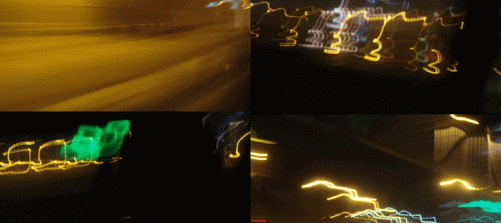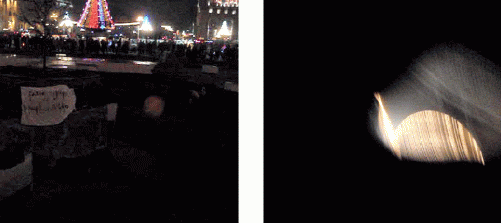IN AND BETWEEN THE (RE)PUBLIC
The Queering Yerevan Collective (QY) has named and defined itself variously since 2007, when a group of artists, writers, cultural critics and activists started to collaborate with each other in various forms to mainly “queer,” appropriate, and use the capital of Armenia, Yerevan, as an experimental space for new cultural production. From the very beginning, the task of the collective has been to disturb habitual perception or to defamiliarize, in a purely Shklovskian sense, by rendering the familiar in unfamiliar terms in order to slow down automated perception. (* 3 ) A QY act, in other words, is a form of slant activism, which differs from conventional acts of intervention that use direct or straightforward language to get across a certain message, or elicit a specific response.
(* 3 ) A QY act, in other words, is a form of slant activism, which differs from conventional acts of intervention that use direct or straightforward language to get across a certain message, or elicit a specific response.
The Queering Yerevan Collective is a loose network of artists, writers, activists, and cultural critics who use Yerevan as a virtual and experimental space for cultivating a queer gaze. The collective was founded in 2007 and organized its first happening in 2008, “Coming To You To Not Be With You,” in the garden of Zarbuyan 34, which became a space for future gatherings and happenings. In 2011 QY published its first book, Queered: What’s To Be Done With Xcentric Art, which includes documentation from various acts and art happenings, photography, critical texts, excerpts from experimental writing, fragments from the QY blog, and email correspondence from 2007-2011.
In our conceptualization of the act that we provisionally titled “Togh lini pat(k)erazm” [Let there be im(war)ge], Arpi Adamyan, lusine talalyan, and I used defamiliarization to question and unsettle specific assumptions (and silences) about queer presences that abound in Armenian culture. The part-scripted and part-improvisational performance took place in the circular basin of a temporarily dysfunctional fountain in the Republic Square, in front of the National Gallery of Armenia. It was aimed at queering and reinscribing a space that has been consistently used as an active official arena during the Soviet era, bearing the statue of Lenin with a platform at its base for Party leaders to address the nation, and later, after the dissolution of the Soviet Union—as a site for protests and demonstrations against the political regime. By the late 2000s, the Republic Square was reclaimed by the new government for holding its military parades and further degenerated into a tourist zone, attracting hundreds of tourists both from abroad and from the provinces of the country. The fountain complex, which was a part of the Square’s architectural composition designed by Aleksandr Tamanyan, was built in 1939 and reengineered in the 1970s to become the most modern spectacle of water and sound in Yerevan. It was repaired and reopened on Independence Day in 2007, having been reinscribed with a new set of symbols such as nationalism, militarism, consumerism, pop culture, etc. As we descend into the fountain basin on January 1, 2010, at 2:11am, the panopticon-like Republic Square is still overcrowded with mostly young people celebrating the New Year.
For us, the concept of im(war)ge is suggestive of a mechanism—a representation—that is at war with itself. It is a self-conflicted, unsettled and unsettling fabula within a Foucauldian panoptic space constructed by the continuous gazes of disciplinary bodies (such as the city mayor, the museum curator, the security, etc.) and the discontinuous gazes of dissident collectivities that aim to “occupy” a space by queering the familiar, the normalized, and the habituated construct. (* 2 ) The space then is transiently inhabited by three artists who are making up their own absurdist “realities” and reinventing the space from the bottom of the Singing Fountains, the main function of which is to enhance the grandeur and power of the state structures such as the House of the Government, the Ministry of Finance and the Ministry of Foreign Affairs that encircle us. Of course, at this opportune moment the fountains have been turned off and aren’t functioning in their “normal” way and this conditions our kairos, which is the classical measure of highly interpretive, situational, and thus subjective timing.
(* 2 ) The space then is transiently inhabited by three artists who are making up their own absurdist “realities” and reinventing the space from the bottom of the Singing Fountains, the main function of which is to enhance the grandeur and power of the state structures such as the House of the Government, the Ministry of Finance and the Ministry of Foreign Affairs that encircle us. Of course, at this opportune moment the fountains have been turned off and aren’t functioning in their “normal” way and this conditions our kairos, which is the classical measure of highly interpretive, situational, and thus subjective timing.
Moving freely in the demarcated space of the basin and swinging a large yellow yarn ball filled with paper like a pendulum, Arpi Adamyan performs a movement that imitates the motion of timekeeping. But the irregular movement that often breaks from the oscillating back and forth pattern also perhaps evokes the swinging wrecking ball, a demolition weapon aimed, on the one hand, at the image of the artist as an inert waiter (both waiting for admittance and waiting on the curator) and, on the other, the museum as a regulatory institution that closets art(ists) in storage vaults. This ideological image of subservient artists producing uniform (heteronormative) “realist” art, whether conforming to the (Communist) Party or Republicanism, still drives the cultural politics of Armenia today. To deflect this conforming gaze, which operates by holding artists such as Sergei Parajanov (1924-1990) or Gayane Khachaturyan (1942-2009) in the waiting rooms of museums that serve as reformatory institutions for nonconformists, Adamyan carnivalizes the repressive processes of such archivization. She proposes a scenario in which the masked artist perverts the silent waiter, who deftly and unobtrusively serves what has been ordered, by temporarily suspending and subverting the rules and regulations at the asylum-museum.
I am partially in drag with painted-on moustache, brandishing a blue dildo in my right hand and “shooting” passers-by. I am also reading out loud an excerpt from my unfinished novel Zarubyan’s Women in Armenian. The sounds of music and firecrackers mute my voice. The selected passage is a contemplation of the mechanisms that automatize and deindividualize power that resides in a complex distribution of bodies, lights, sounds, and gazes in which the unhistoried characters are caught up.
Lying prostrate on the ground, lusine talalyan’s gaze is interrupted by transitory death, boredom, desertion, an erotic dream—if the image is an image of war and if the image is at war with itself, then talalyan participates only through an absented presence, a presence that flickers like the Derridian cinder: “By its retreat it still feigns having abandoned the terrain. It still camouflages, it disguises itself, beneath the multiplicity, the dust, the makeup powder, the insistent pharmakon of a plural body that no longer belongs to itself—not to remain nearby itself, not to belong to itself.” (* 1 ) Her gender is indiscernible, like the cinders, she changes sex, she re-cinders and “androgynocides” herself. Lying on a headscarf that is nearly identical with the keffiyeh famously worn by Yasser Arafat, talalyan frames war and its dehumanizing rhetoric that untraces the lives of Palestinian wo/men. This is the iconic image of war that both contaminates and numbs the viewer—it contaminates with a desire to participate, and it numbs through its proliferation in various forms of mass media—one becomes accustomed to life in war.
(* 1 ) Her gender is indiscernible, like the cinders, she changes sex, she re-cinders and “androgynocides” herself. Lying on a headscarf that is nearly identical with the keffiyeh famously worn by Yasser Arafat, talalyan frames war and its dehumanizing rhetoric that untraces the lives of Palestinian wo/men. This is the iconic image of war that both contaminates and numbs the viewer—it contaminates with a desire to participate, and it numbs through its proliferation in various forms of mass media—one becomes accustomed to life in war.
So when a group of young men notice and approach us at the end of our seventeen minute act, they immediately identify and isolate the familiar visual codes of militarism and war, including the poster with the title “Let there be im(war)ge,” choosing to read it—“Let there be war.” The performance is perceived as an act of treason, and the artists as polluters of high cultural values such as masculinity, republicanism, national and military pride. And yet there is a lingering sensation of surprise among the viewers, as the familiar representation of war, naturalized by those very cultural values that they dogmatically uphold, is re-experienced in a new heterodox translation.
Shushan Avagyan ( 2013): IN AND BETWEEN THE (RE)PUBLIC. In: p/art/icipate – Kultur aktiv gestalten # 02 , https://www.p-art-icipate.net/in-and-between-the-republic/





 Artikel drucken
Artikel drucken